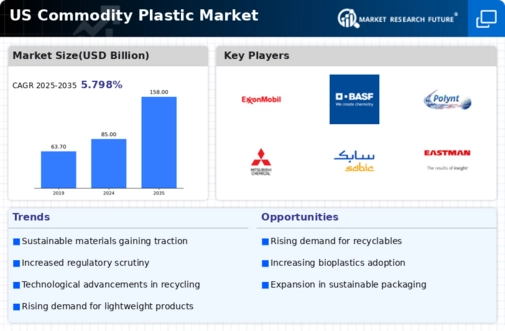The US Commodity Plastic Market is characterized by a competitive landscape that has become increasingly dynamic over the years, shaped by shifting consumer preferences, technological advancements, and environmental considerations. Notably, the market comprises various players who specialize in the production of different types of commodity plastics, such as polyethylene, polypropylene, and polystyrene. These materials are essential in a wide array of applications, including packaging, automotive components, construction materials, and consumer products. Competition in this space revolves around factors such as pricing, product innovation, manufacturing efficiency, and sustainability initiatives.
As demand continues to evolve, companies in this market are facing the challenge of balancing growth opportunities with the imperative for environmentally responsible production practices.In the realm of the US Commodity Plastic Market, Dow has carved a significant presence with its robust portfolio of innovative products and strong industry expertise. The company is recognized for its advanced technologies and manufacturing capabilities, which enable it to produce a diverse range of plastic solutions that cater to various applications.
What sets Dow apart is its commitment to sustainability and circular economy principles, leading to the development of eco-friendly materials such as bio-based plastics and recyclable solutions. Dow's strong distribution network and strategic partnerships allow it to maintain competitive pricing and enhance its market reach. By focusing on research and development, Dow continually introduces innovative products that meet changing regulatory standards and customer demands, further solidifying its position in the market.ExxonMobil also plays a prominent role in the US Commodity Plastic Market with its vast manufacturing footprint and extensive portfolio of petrochemical products.
The company offers a wide range of commodity plastics, including polyethylene and polypropylene, which are vital for various industries. ExxonMobil benefits from its downstream integration and a strong supply chain, which enables it to deliver competitive pricing and high-quality products efficiently. The company has made strategic investments in expanding its production facilities in the US, allowing it to respond to market demands effectively. Additionally, ExxonMobil is active in pursuing mergers and acquisitions to enhance its market positioning and technological capabilities in the commodity plastics sector.
Its focus on innovation, operational excellence, and sustainability initiatives contributes to its strengths in the highly competitive landscape of the US Commodity Plastic Market.






















